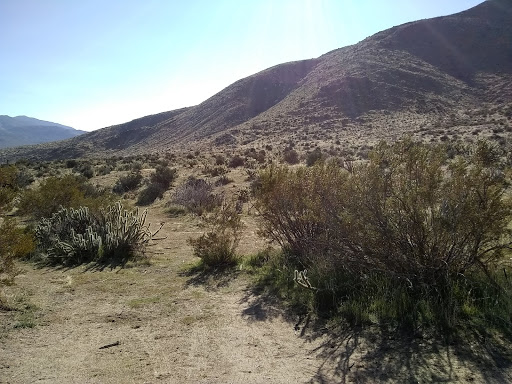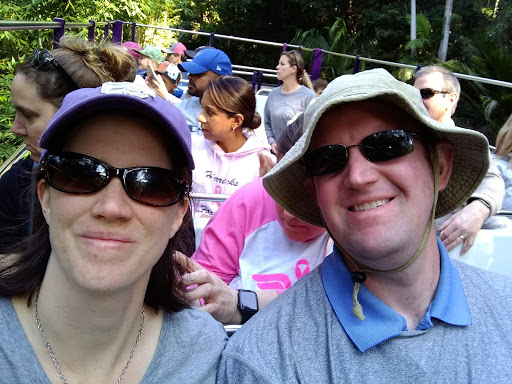In all seriousness, Joshua tree is extraordinary. The area divides into several discreet microclimates, of which the Joshua trees actually only inhabit a portion. They produce large fruits from which seeds sprout and plant. In a bygone era, giant land sloths ate those fruits and distributed those seeds via the end of their GI tract far and wide; without their nomadic carriers, the range of these plants has diminished and become far more concentrated.
We began our journey at the visitor center, which was very informative; see the preceding two paragraphs. Our day consisted of several short hikes taking place among the park's many attractions. The first, Hidden Valley, was an illustration of how much life can exist even in the heat of a desert. Hidden Valley was actually used for grazing cattle back in the day; the 'hidden' is a nod to the likely overblown claim that cattle wrestlers would hide their ill-gotten bovine herds in the seclusion of this spot. An oak species particular to the region grew stately; apparently their seeds was an important food source for native peoples. All around giant rock formations made the place feel otherworldly.
We headed on to Barker Dam, where man's intervention really did allow for flourishing cattle grazing. While the water level was still low, it was still great to see the colors and life of a desert. As we traversed from place to place, we munched happily on snacks Alex picked up at a local gas station on our way to Joshua tree. Of her selections, the yogurt pretzels were particularly prized, and these snacks kept us going the whole day without ever having to actually stop to eat, maximizing our time in this strange world.

Were we to stop for lunch, Keys View would have been quite the option. This high point gives a lovely view of the park. Our view extended beyond the San Bernadino Mountains (the map points out they are the "Little" San Bernadino Mountains, stature need not be equated with stateliness) to over the San Andreas Fault into the Coachella Valley. We pulled up to the spot, took in the view, and understanding the need to maximize the day took off, following a cyclist who, having exerted the effort of climbing to this high point, enjoyed coasting in front of us all the way down.
While Keys View was a scenic point, the longest hike of the day and highest point in the park actually belongs to Ryan's Mountain. Alex and I excited hiked the craggy landmark. The peak offered a great view of the park's delineation between the Mojave and Colorado deserts. It was fascinating to note the plant life on either sloping side. (Note from Alex: this was about 1000' in elevation over 1.5 miles to the top. Arthur scampered up like a mountain goat with his new physique while Alex, also sporting a new physique with pregnancy, huffed and puffed some but the view from the top overlooking the entire park was worth it.)

We drove quickly past one of the park's main attractions, Skull Rock, whose popularity and road proximity offered little hiking and even less parking. We felt like we captured the essence of the place as we slowed down to view the skull-like formation. Aptly named, we commented approvingly.
Instead, our next stop was actually towards Split Rock, another apt if perhaps overly literal name. This formation offered a beautiful trail full of wondrous scenes beyond what even the titular attraction proffered. We saw pictograms painted onto the rocks by people from past millennia and enjoyed the rocky terrain.

Our day was rapidly heading to conclusion. Among the microclimates of this park, the Cholla Cactus garden left an indelible memory. Cholla cacti are a particularly prurient plant, they cloth themselves in needles so thick that from a distance it looks like they're wearing wool. Up close, their prickly personalities dispel with any thought of cuddliness; some swear the plant will shoot its needles at you should you venture closer than propriety allows. It was truly curious why this particular section of the park would be so thoroughly dominated by one plant, and I have never found a reason for it.

Past the Cholla came the Ocotillo patch, another cacti species who looked downright friendly after hanging out in the Cholla gardens a while. We didn't spend much time there; we hoped to hit Cottonwood Spring oasis before sunset. It seems strange to aspire to visit a place named for the presence of a tree species growing in our own backyard, but indeed seeing deciduous trees of any variety is noteworthy in such a world as this.

In Joshua Tree, we hiked roughly 10 miles between our various stops. We did not break for lunch as we had noted, and while our snacking sustained us, I think we were both pretty excited to eat that night. Alex pulled up a local eatery named Aqua California and we dined on a sumptuous three course meal (per the recommendation of our waiter who steered us towards the good deal), with soup, entree, and dessert, thank you very much for that extra 's'. Splitting our courses between us, that amounted to quite the meal, though we both opted for the mushroom soup to begin the event.

And so it was that we headed back from a full day in the desert.
The next morning we got an early start after saying farewell to our B&B hostess who had even gave us a gift for our soon to be little girl. We had to drive back to San Diego before our flight that afternoon. We opted for the interstate route which also took us around the mountains rather than up and over. Arthur did a great job dealing with the California traffic on the multilane interstate. As we were getting closer to San Diego it started to downpour-- the only bad weather we had on the trip. This slowed traffic down and we were hoping it wouldn't impact us getting to our flight. Everything worked out great-- finding a gas station, dropping off the rental car, and cruising through security. Once on the plane prior to take off someone had a medical emergency which required returning to the terminal, unloading them and their checked luggage, and redoing safety checks which put us over an hour delayed on take off. Most people on the plane were scrambling to reschedule connecting flights so it was nice for us that we had plenty of time for our layover and could relax. Once we arrived in Dallas we enjoyed dinner and walking around the terminal before catching the flight back home. Landing at the airport in the middle of February Arthur maybe looked a little out of place with his shorts and sunburn-- but that is what vacation is for.
Omnia Vincit Amour.










































